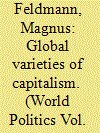| Srl | Item |
| 1 |
ID:
165597


|
|
|
|
|
| Summary/Abstract |
This article analyzes the prospects for globalizing the varieties of capitalism (voc) debate. It identifies and compares firm-centered, governance-centered, and state-centered approaches to extending the debate on capitalist diversity, and discusses the distinctive contributions of each approach as well as the trade-offs between them. The author draws on three agenda-setting volumes that engage with the voc framework and study capitalist diversity in three regions not usually covered by this literature: Latin America, East and Southeast Asia, and East Central Europe. As these regions play an increasingly important role in the world economy, this article examines what the books imply about the current state of knowledge about global voc. The author argues that the extension of the voc debate to these parts of the world is important for advancing the understanding of economic institutions; the approach can reinvigorate research on capitalist diversity and the institutional foundations of economic development in the current era of globalization.
|
|
|
|
|
|
|
|
|
|
|
|
|
|
|
|
| 2 |
ID:
184391


|
|
|
|
|
| Summary/Abstract |
There are many shared historical experiences and similarities between Iran and China. Both are legacies of the long-lasting empires and civilisations in West and East Asia, respectively. Like other great Asian empires, Iran and China were confronted with the expansion of the European imperial powers in the early-nineteenth century which ultimately led to the dislocation of these ancient empires. Both countries had resisted pressures towards peripheralization in the global economy by the creation of nationalist popular revolutions and by building modern nation states and identities in the first half of the twentieth century, despite different political systems, cultures, and external relations. Both Iran and China have been trying to escape from the external pressures and internal socio-economic backwardness by the modernization of their states, societies, and economies via a state-led catch-up development strategy. These efforts led to the rise of China in the late-20th century and the emergence of post-Islamic revolutionary Iran 1978/79 as a ‘contender state' to the hegemony of the United States (US) in West Asia. This development raises two key questions: why did China succeed in rising as an industrialised regional and global power, and has Iran’s development strategy failed so far?
|
|
|
|
|
|
|
|
|
|
|
|
|
|
|
|